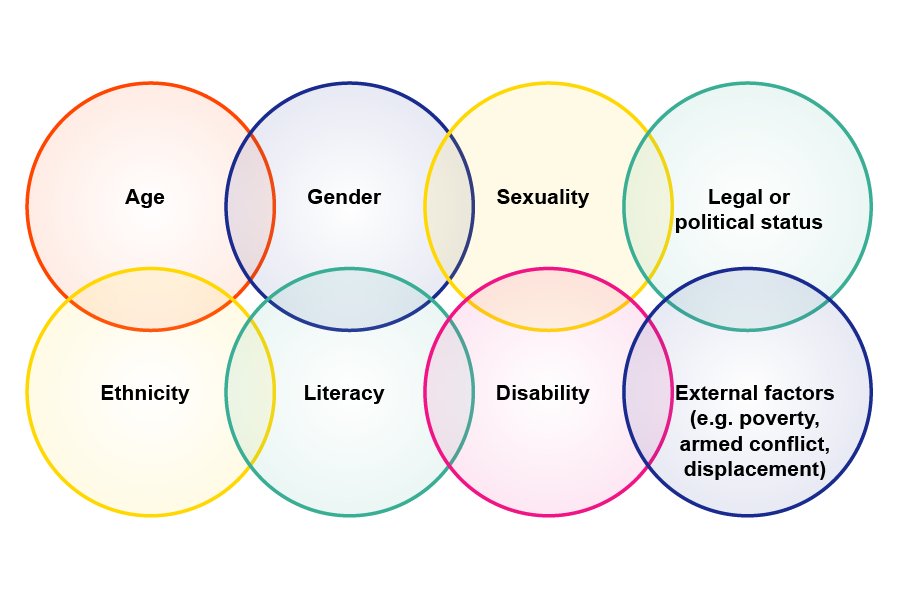Gender plays a significant role in safeguarding, with differing groups in differing contexts having an important impact on identifying risks. We explore the role of gender and the considerations that need to be accounted for.
What role does ‘gender’ play?

The term ‘gender’ is used to refer to the societal perceptions of the roles men and women play in society. It is not about the biological make-up of a man or a woman (which is known as ‘sex’). People sometimes believe that what constitutes a man being
‘masculine’ or a woman ‘feminine’ are grounded in biology, but actually they are learnt through socialisation.
Societal perceptions of the role of a man and a woman often underpin power differentials and inequality which could make girls and women more vulnerable to SEAH. SEAH occurs because of inherent power inequalities and differentials in the aid sector.
Using a ‘safeguarding lens’ (think of this as putting on spectacles) when working with beneficiary communities, alerts us to the importance of identifying, preventing and responding to the diversity of ways that men, women, boys and girls might be made
vulnerable to being harmed, particularly to SEAH.
|

Activity 2.3 Gender and safeguarding
Why is gender an important factor when thinking about safeguarding?
Record your response in your learning journal.
View comment
|
What is intersectionality?

View transcript
NARRATOR: What is intersectionality? Intersectionality is a way of understanding social relations by examining intersecting forms of discrimination. This means acknowledging that social systems are complicated, and that many forms of oppression, like
racism, sexism, and ageism might be present and active at the same time in a person’s life. Everyday approaches to building equality tend to focus on one type of discrimination, for instance sexism, and then work to address only that specific
concern. But while the career of a young white and able-bodied woman might improve with gender-equality protections, an older, black, disabled lesbian may continue to be hampered by racism, ageism, ableism, and homophobia in the workplace.
Intersectionality is about understanding and addressing all potential roadblocks to an individual or group’s wellbeing. But it’s not as simple as just adding up oppressions and addressing each one individually. Racism, sexism, and ableism exist on
their own. But when combined, they compound and transform the experience of oppression. Intersectionality acknowledges that unique oppressions exist but is also dedicated to understanding how they change in combination. The roots of intersectionality
lie within the black feminist movement with legal scholar, Kimberly Crenshaw, originating the term. Crenshaw felt that anti-racist and feminist movements were both overlooking the unique challenges faced by black women. She stated that legislation
about race is framed to protect black men, and legislation about sexism is understood to protect white women.
So, simply combining racism and sexism together does not therefore protect black women. Intersectional theory is now applied across a range of social divisions and also to understandings of domination, such as those associated with whiteness, masculinity,
and heterosexuality. Intersectionality is not only about multiple identities. And it’s not a simple answer to solving problems around equality and diversity. It is, however, an essential framework as we truly engage with issues around privilege
and power and work to bring them into the open. Intersectionality means listening to others, examining our own privileges, and asking questions about who may be excluded or adversely affected by our work. As importantly, it means taking measurable
action to invite, include, and centre the voices and work of marginalised individuals.
Reference: Crenshaw K (1989)
In some cases, a child or an adult could have a combination of inherent factors which make them vulnerable.
We call this ‘intersectionality’ – the overlapping or intersecting of identities and the experiences of oppression and discrimination of men, women, boys and girls. Intersectionality recognises not only differences between identities (such as race, gender,
and gender identities), but also differences within these identities.
For example, the experiences of women of an ethnic minority will often be different to women who are from an ethnic majority group. Where the interconnected nature of social categories such as race, class, and gender apply to a given individual or group,
it creates an overlapping interdependent system of discrimination or disadvantage that leaves a child or adult vulnerable to the risk of greater harm.

|

Activity 2.4 Using intersectionality
Consider the following two questions and record your response in your learning journal:
- Why is identifying vulnerability using intersectionality helpful when implementing safeguarding?
- What is the impact of intersectionality on people your organisation supports?
View comment
|

![]()

